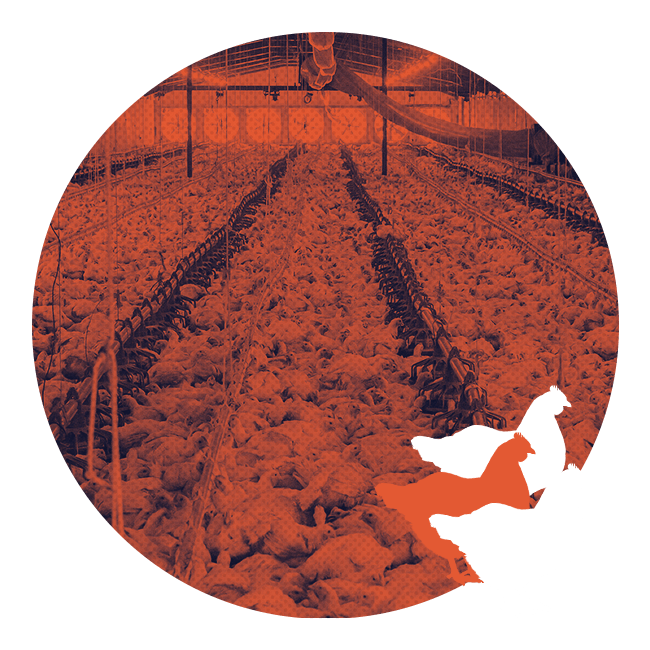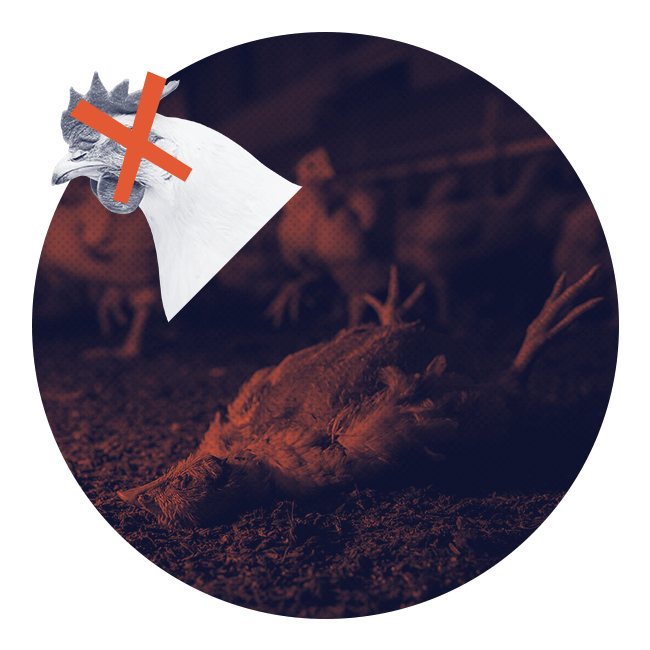Learn about some of our approaches:
- Negotiation with companies to publish broiler welfare commitments
- Free training on broiler welfare for companies (schedule here)
- Development of technical materials
- Lectures at Universities (schedule here)
Brazilian chicken meat production
chickens slaughtered per year
largest producer in the world
largest exporter in the world
ABPA 2025 - reference year 2024
The most commonly raised terrestrial species for human consumption is subjected to terrible conditions in confined systems.
When the industry operates on a large scale to produce the cheapest meat, animals pay a steep price.
Confined in generally closed and overcrowded systems, the birds can barely walk and spread their wings.
Image: We Animals

There is no stimulus for the chickens, such as pecking material or perches.
In the first days of the birds’ lives, lights are continuously turned on to make them more active and eat more feed. They gain weight faster but are unable to rest properly. In some farms, they are kept in the dark to make them less active and lose fewer calories.
The floor becomes dirty with waste, which decomposes, releasing ammonia and carbon dioxide into the air, which affects the birds’ health.
Image: We Animals

For decades, the industry has genetically selected desirable characteristics in chickens, such as accelerated growth, to produce more meat at a lower cost. However, this leads to a range of health issues, such as bone and joint problems, heart and lung overload, skin and paw injuries.
Image: We Animals

Antimicrobials are added to the feed to help the birds absorb more nutrients, and gain weight faster.
These medications can also be applied to prevent diseases, as the crowded and confined environment increases the risk of spreading bacteria, viruses, and fungi.
This indiscriminate use can generate resistant bacteria (superbugs), compromising the treatment of diseases in both birds and humans.
Image: We Animals

During of slaughter, chickens are hung upside down by their legs on moving metal structures, causing discomfort, fear, as well as pain if handled aggressively. They flap their wings as they try to return to their natural posture, which can cause bruises and even fractures.
Their heads are then immersed in a tank of electrified water to render them unconscious before slaughter. This procedure does not always work as intended, and the chickens may feel both the electric shock and the pain of having their necks cut for bleeding.
Image: We Animals

- Reduce overcrowding
- Never use cages or multi-level systems
- Provide perches or platforms, and material for pecking
- Provide daily periods of (natural) light and darkness for birds to rest
- Monitor and control air quality
 Imagem: Freepik
Imagem: Freepik - Only for the treatment of diseases
- Adopt breeds that demonstrate better animal welfare results
 Imagem: Freepik
Imagem: Freepik - Use effective and painless stunning methods
- Avoid live inversion
 Imagem: Freepik
Imagem: Freepik Alianima works to improve the lives of broilers.
To achieve this, we work collaboratively with producers, the food industry and government authorities, ensuring animal welfare policies that address the points above.
All of our work has a technical-scientific basis, supported by a team of experts specialized in animal welfare.
Learn about some of our approaches: